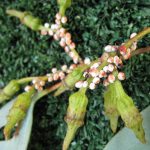
Current Plant List
By Charlie / in General / May 14, 2019

With the COVID19 virus keeping many people in their homes and restricting their movements, we are trialing an online shop to allow our customers to purchase their plants on-line and have them ready to be picked up from the nursery or - if you live in the Perth metropolitan area - delivered to your front door.
We are still open to the public, if you do visit, please abide by the social distancing regulations.
We currently have over 350 species online in tubes. These will be updated as more become available.
Our delivery and shipping rates are
Please note - in order to get the shop up and running quickly it is not perfect and needs refinement ,so it has some quirks -
Gardening reduces social isolation,
reduces self-harm,
reduces stress,
can lower the body mass index,
provides low impact exercise,
reduces negative thoughts
and damaging behaviour,
improves rehabilitation,
is calming and is empowering for people".
Burton, A 2014. Gardens that take care of us. The Lancet Neurology, Vol. 13 (5) pp. 447-448
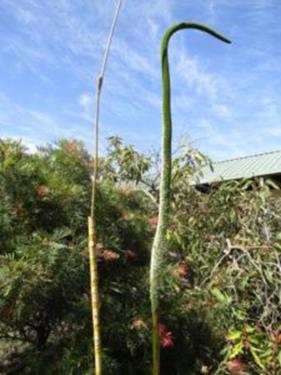
The Grass Tree flower stem growth has now almost stopped and the beautiful little white flowers first appeared on 4th November.
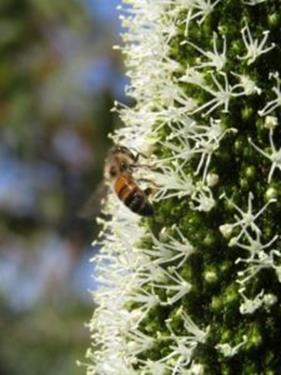
A honey bee attracted to the grass tree flowers.
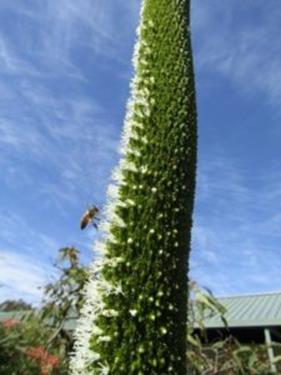
These small white flowers are beautiful when seen up close.
I grew this Xanthorrhoea from a seed and planted Xanthy in this flowerbed 13 years ago. Xanthy will not start growing a stem from several more years but I consider a Grass Tree is just as attractive looking like this and is a great addition to any garden.
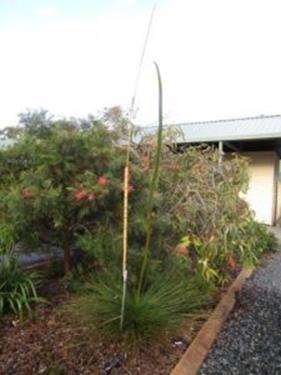
Xanthy's total height is now 270cm. Xanthy is averaging 3.25cm per day.
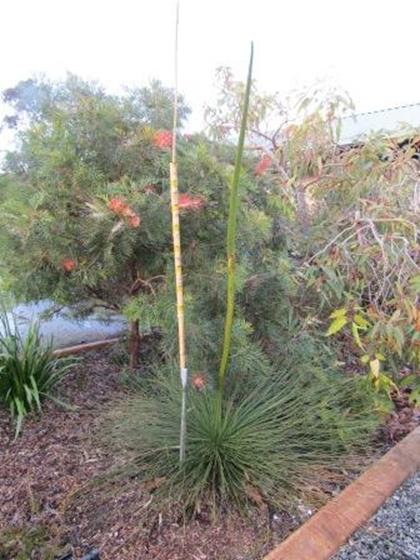
Flower spike on Xanthy our Xanthorrhoes preissii (Grass Tree) 2nd October 2016. This has grown 112cms in 29 days, average of 3.8cm per day.

Xanthy our Xanthorrhoea preissii or commonly called a Grass Tree. We were surprised by the amazing flower stem growth up until the 2nd of September. So we decided that we would start measuring the growth every day at 4.30pm.
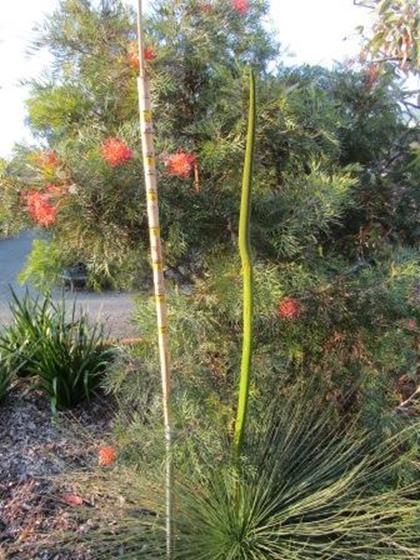
Our Xanthorrhoea preissi has grown 60cm in just 13 days!
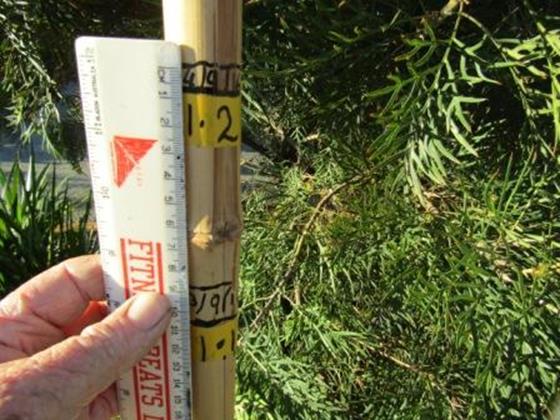
Xanthy grew 9cm in 24 hours between 3rd September and 4th September. Both the 3rd and the 4th were fine sunny days. The flower spike is 1.22 metres tall.
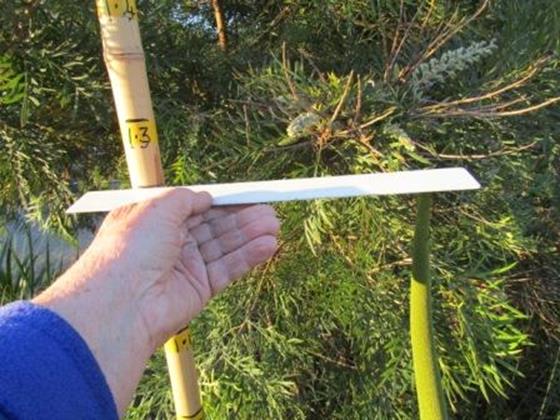
Showing the flower spike at 1.22 metres tall on th 4th September.
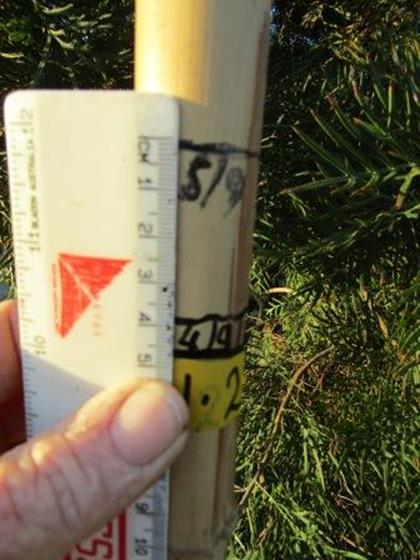
Indicating a 4cm growth on the 5th September.
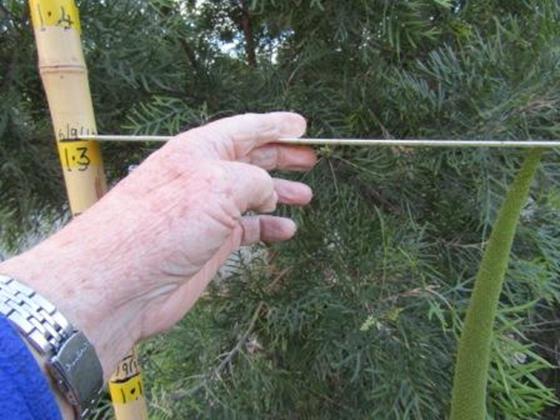
Xanthy's growth by the 6th September, 1.3 metres tall
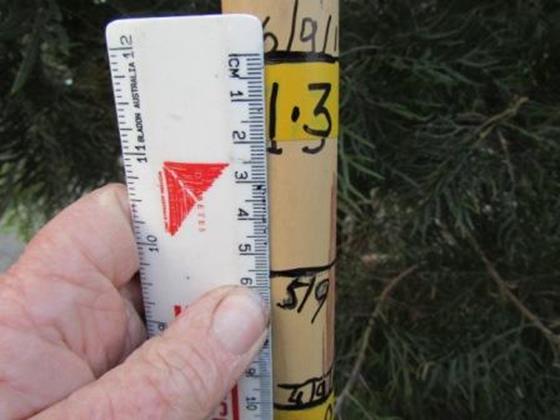
Xanthy's growth of 5.5cm on the 6th September. Total growth since 3rd September = 18.5cm. The day was fine but cloudy.
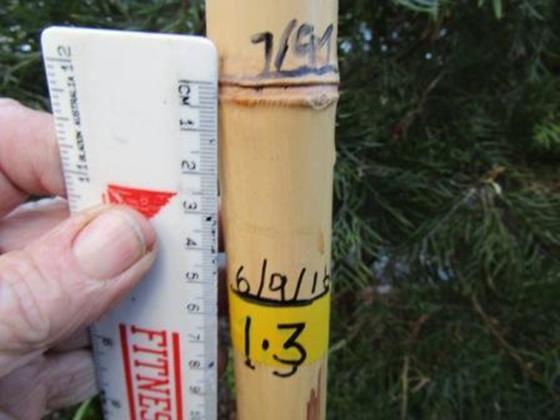
Xanthy's growth by 7th September 5cm. Rain over night and nearly all day. Windy and Cold.
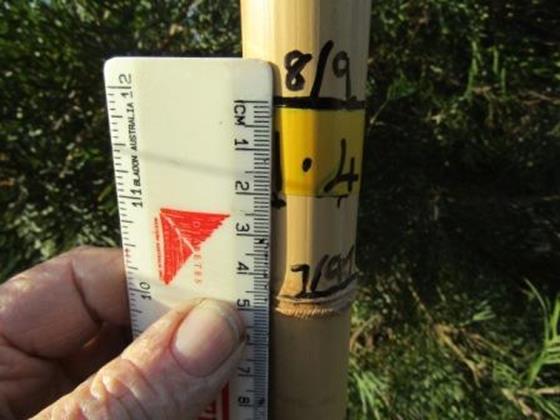
Xanthy is now 1.4m tall having grown 4.5cm in the last 24 hours. The day has been clear, cool and sunny.
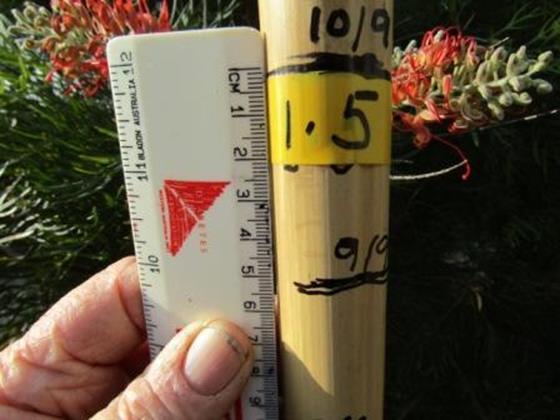
Xanthy's growth by 4.30pm on 10th September. The weather has been sunny, cool but with some rain over night.
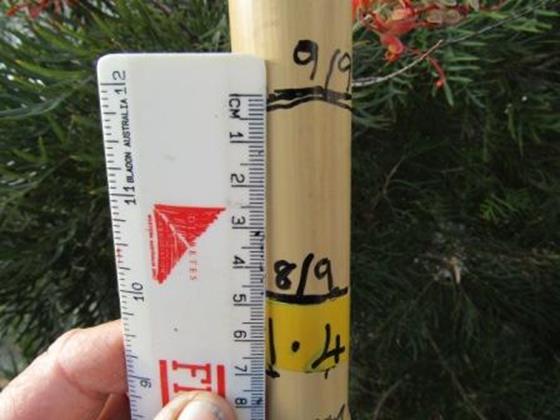
Xanthy's growth on 9th September. The weather has been bright and sunny.
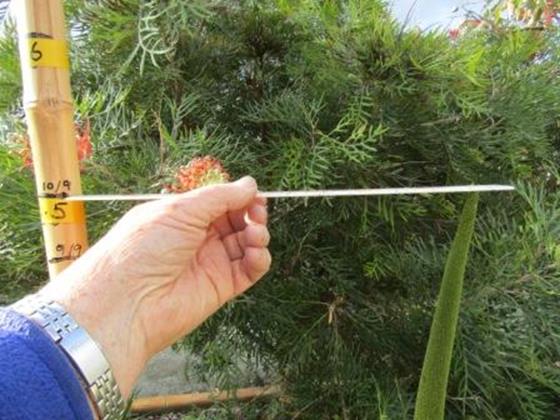
Xanthy's growth 10th September - 5cm. Total height 1.5metres.
Yesterday and today our garden has received some very much appreciated rain. We do not have any irrigation in the majority of our flowerbeds so I will show you photos taken this morning, between rain downfalls, of some of the beautiful flowers our native garden plants have produced after a long hot summer with almost no rain. These plants demonstrate very clearly that the majority of our Western Australian native species are very waterwise and that they require little or no water. Anyone with an Australian native garden that is watering more than once a month in summer is killing their plants with kindness. Plants that receive too much additional water do not live as long as those that receive little or no additional water. There are many other autumn flowering plants that I could have photographed today, some of them also continue flowering into winter. For example, all the Correas, some Scaevolas, many Hakeas, Boronia crenulata, some Lechenaultias, this list could very easily go on!
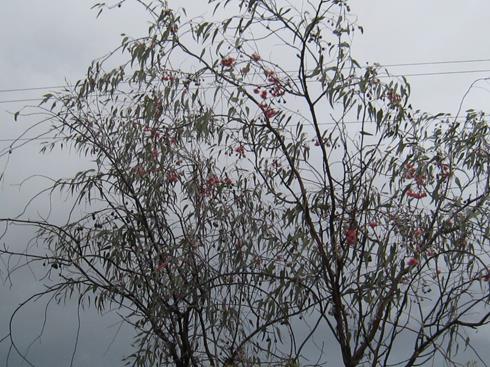
Eucalyptus caesia commonly called Silver Princess. When photographed against a grey sky like we have today, it is very attractive.
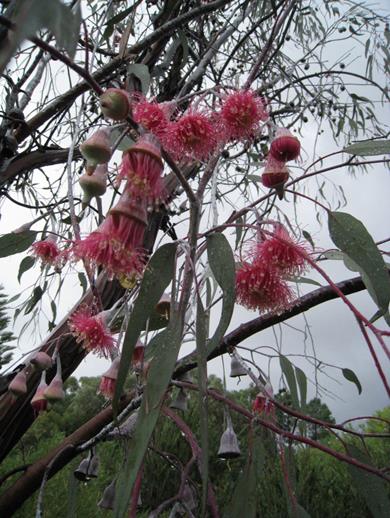
The beautiful flowers of the Eucalyptus caesia or Silver Princess, a grey sky behind and covered in welcome rain drops.
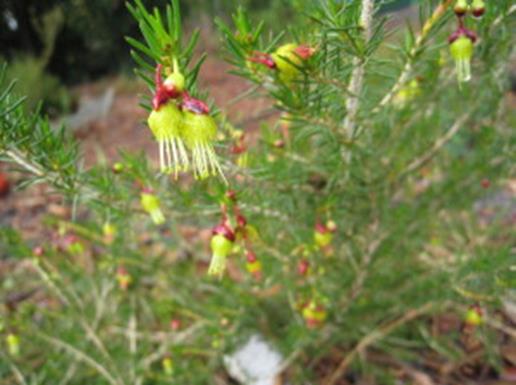
Verticordia staminosa which is a very waterwise small shrub.
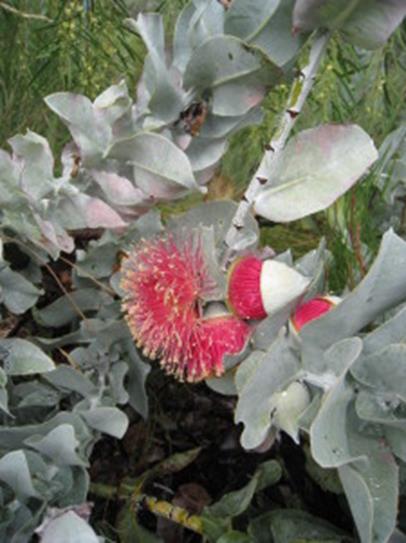
Eucalyptus macrocarpa which is commonly called Rose of the West.
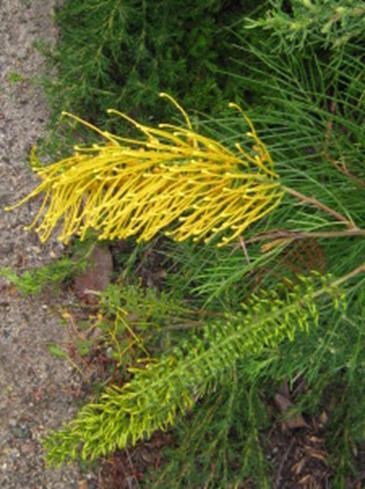
Grevillea Golden Lyre has just started to flower after a long dry summer with no irrigation.
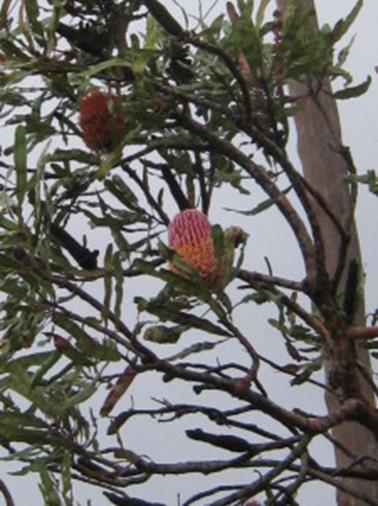
The beautiful Banksi menziesii or Firewood Banksia that has been flowering for several weeks.
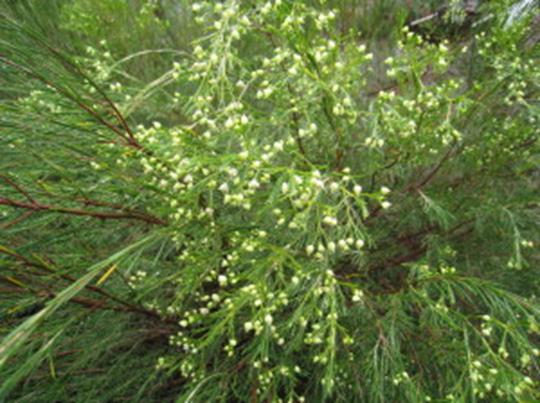
The lemon bud wax of Chamelaucium Lemon Drops. It makes a good addition to flower arrangements.
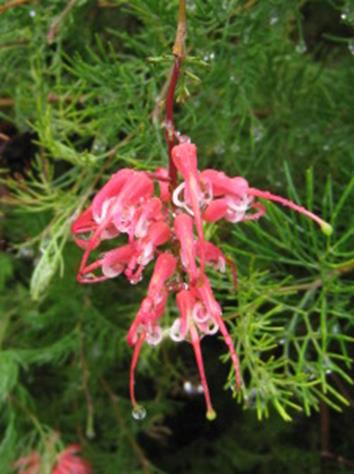
Grevillea Ellendale Pool which has been flowering for the past 4 months with no irrigation making it very waterwise.
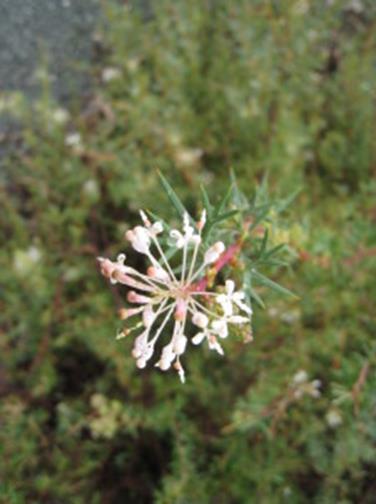
Grevillea phanerophlebia with it masses of white flowers is very waterwise and flowers all year.
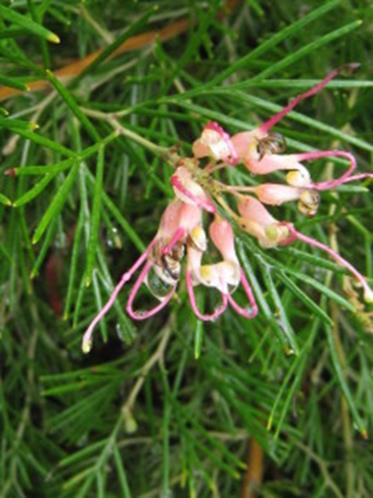
Grevillea Carramar Gold that has been growing in our garden for about 20 years, is very dense and very waterwise. It has never received any irrigation.
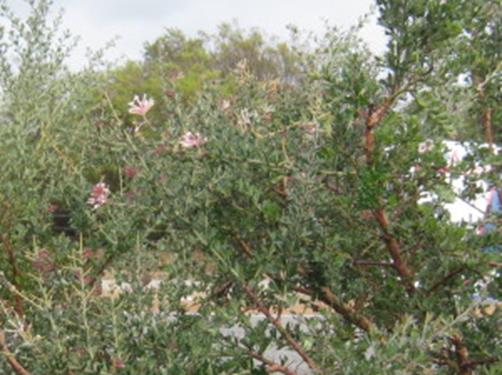
Grevillea vestita, this is the pink flowering form. It flowers twice and year for a long period each time.
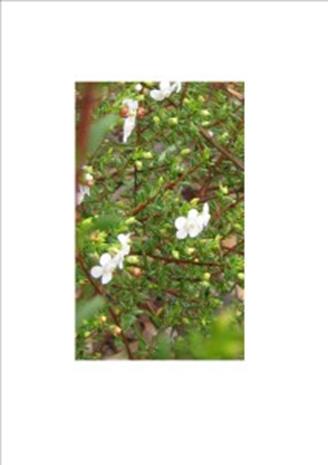
Chamelaucium ciliatum or commonly called Albany Wax is just breaking into flower in our garden. It has masses of attractive little white flowers.
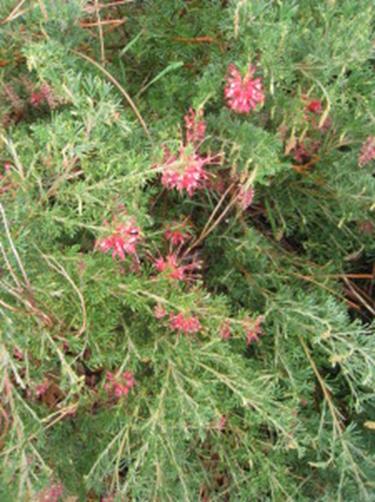
Grevillea Ellendale Dragon is a low growing attactrive shrub with grey/green leaves. It is very waterwise.
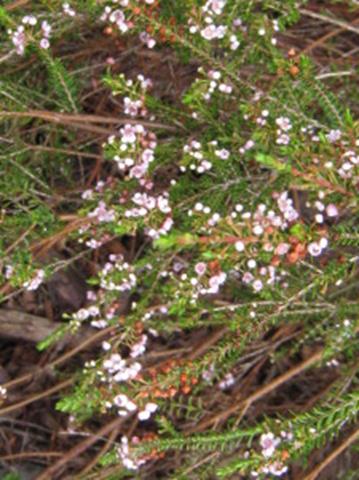
Thryptomene saxicola is a very waterwise, long lasting, adaptable shrub. A good addition to almost any garden where there is good drainage.
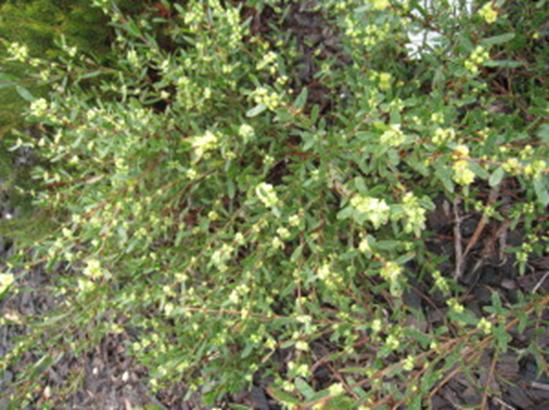 Hypocalymma xanthopetalum is a small shrub which flowers all year regardless of whether it is irrigated or never receives any irrigation.
Hypocalymma xanthopetalum is a small shrub which flowers all year regardless of whether it is irrigated or never receives any irrigation.
Our WA Christmas trees are beautiful but many of them are dying from actions by us humans. Mostly they are being bulldozed for housing, industrial developments or people are failing to protect them on their properties from damage by their livestock.
The WA Christmas tree is very unusual. It has no relatives and is classed in a genus by itself in the mistletoe family. Unlike other mistletoes that grow on the branches of their host trees, the WA Christmas tree grows in the ground. It is partially parasitic which means that its roots make rings round the roots of nearby plants and then extracts water and nutrients from those plants.
The WA Christmas Tree is the only plant in the mistletoe family that has seeds that are wind dispersed. The seeds have wings on them but because the seeds are quite large they often land just a few metres from the parent tree. The majority of seeds are eaten by ants and other creatures, or they are not able to germinate due to the circumstances not being ideal for germination.
During the flowering period which is now, the flowers are a rich source of nectar for the nectar eating birds and insects for the insect eating birds.
The trees develop thick trunks which are made from a starchy tissue which horses love to eat and they continue to chew until they kill the tree. It is important to fence off the WA Christmas trees from horses. It is also important that large numbers of animals are not allowed to stand under these trees, or any trees for that matter, for shade. The compaction of the ground by the hooves of livestock, particularly cattle and horses, can slowly kill a tree.
The weight of the flowers and leaves of the WA Christmas Tree often causes branches to break off the trees which gives them an irregular, often battered, look.
We do not fully understand the WA Christmas Tree and how to give it the best chance of survival when planted into a garden or a bushland setting. In their natural setting they appear to be tough and adaptable. They can be seen growing over a large area from Kalbarrie to Iraelite Bay which includes many different soil types and situations. In reality nobody knows how to help them to grow successfully in gardens or bushland.
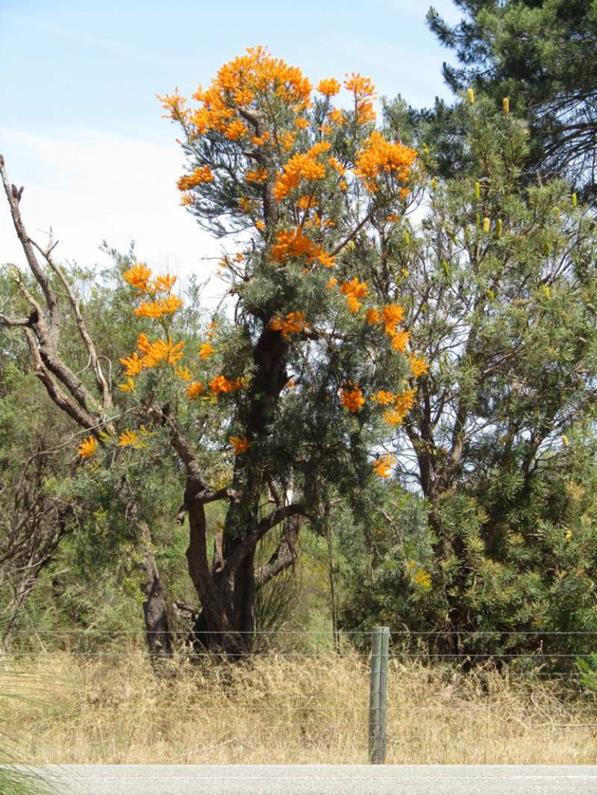
This is the beautiful Western Australian Christmas tree which is flowering now. Its Latin name is Nuytsia floribunda. This an old tree showing wind damage due the weight of the leaves and flowers.
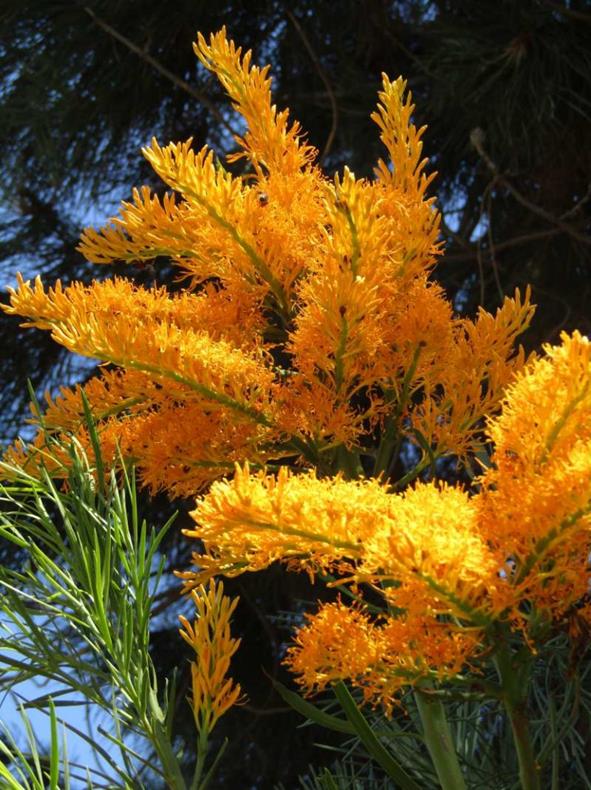
The beautiful flower of the Nuytsia floribunda commonly called the WA Christmas Tree
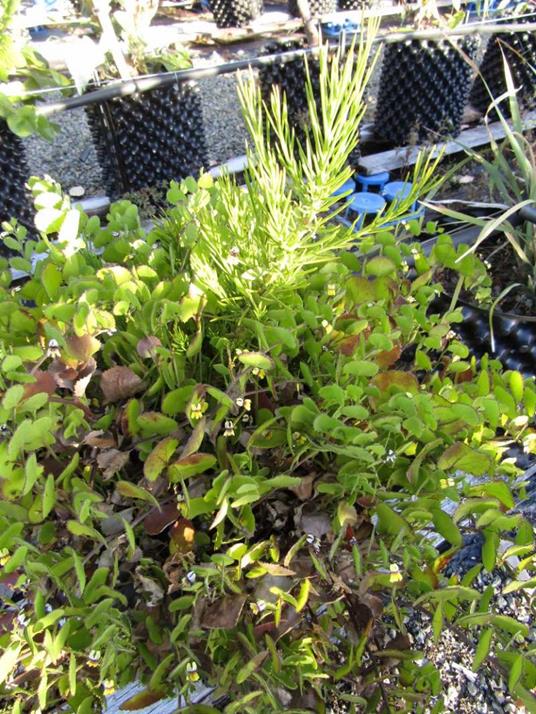
Growing WA Christmas trees in pots is almost unknown because it is problematic. This one is 2 years old and growing in a 23 litre Rocket Pot with a Goodenia varia as its host plant. Perhaps the wrong choice of host plant because the host has grown too big. When this is planted into a garden bed it will be interesting to see the result.
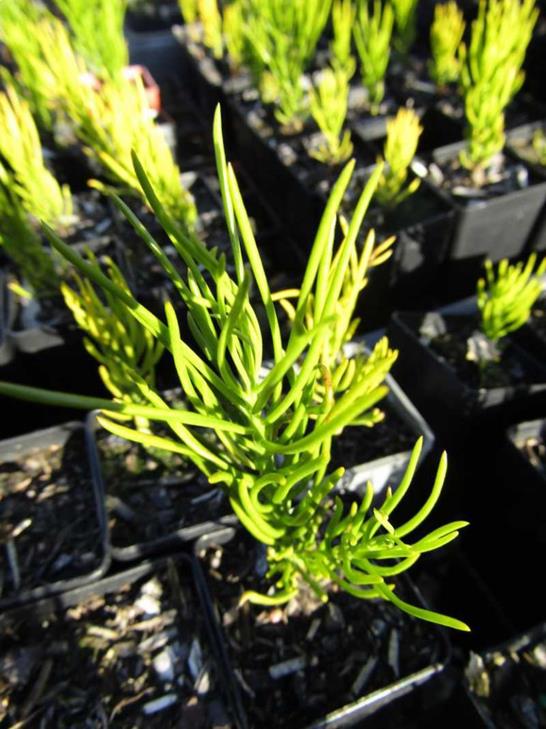
Growing WA Christmas Trees for sale in tubes can be problematic. Some die, like the one on the left and others don't grow very fast like several on the right, yet they were all planted at the same time.

Montie who considers that he owns the road verge outside his house in the suburb of East Victoria Park.
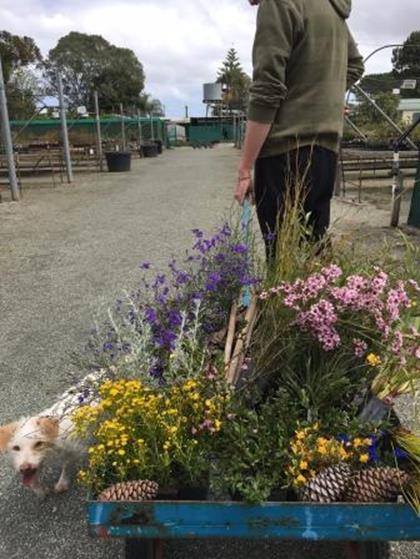
Here is Montie last week helping to choose tubestock in our nursery of Western Australian natives plants for adding to the his road verge and front garden.
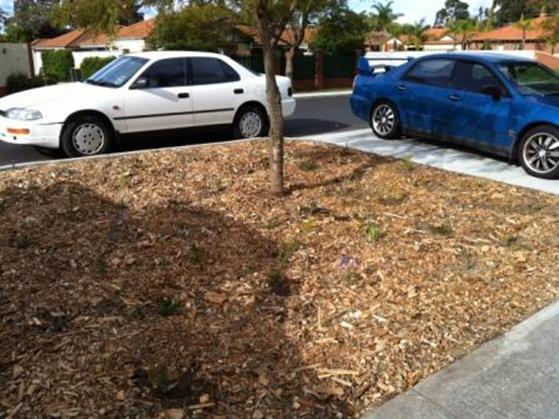
August 2014 the planting of Montie's road verge was started.
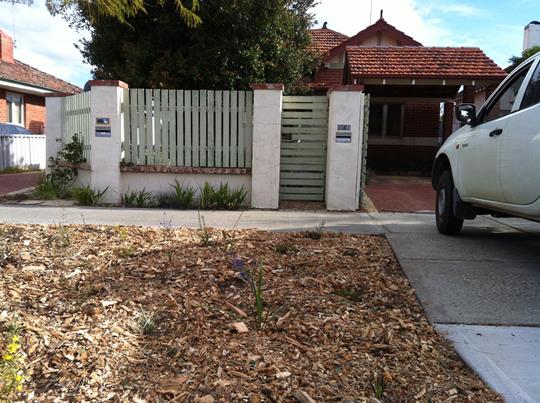
Another photo of this newly planted W.A. native road verge August 2014.
This photo was taken just after the planting using tubestock plants in August 2014. The best way to achieve success when planting is to use native tubestock plants that can grow in the soil type of the road verge. The soil type of East Victoria Park is grey Bassendean Sand. Plants suitable for this soil type were chosen.
It is important when planting to dig deep and wide holes. This breaks the compaction of the sand and makes it much easier for the roots of the native plants to penetrate downwards. This planting method will create a very waterwise verge that will require little or no watering, particularly during the summer months. When plants have been grown in square tubes the roots do not root bind (go round and round in the tube or pot). This helps the plants to establish much quicker. Using a rough mulch such as in this photo is helpful as it keeps the surface of the sand cooler in summer and it also helps to supress weeds. However, mulching is not essential. If you want to plant up your verge or garden with natives on a tight budget, just buy tubestock and be prepared to dig big holes. Do not install irrigation. Once established this road verge will survive with little (from a hose and tap) or no irrigation. When doing the 'little' irrigation, it does not mean 'little and often' which encourages shallow rooted, unhealthy plants. It means that the plants should be watered seldom but thoroughly.
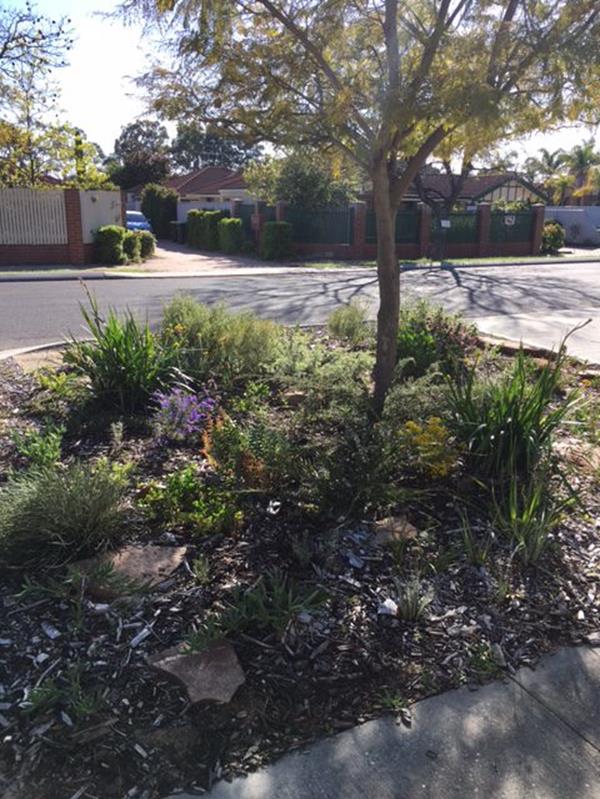
2016, in 2 years the verge has grown from nothing to this attractive W.A. native road verge.
This road verge E. Victoria Park is different to all the other verges in the street. A few look like the ones on the opposite side of the road in the above photo. They are manicured lawn and require a lot of water to keep them a beautiful green. This type of road verge not only requires valuable water, but also maintenance work like regular mowing and weeding. Almost all of the other verges in this street in East Victoria Park are just brown grass and weeds. They do not require any water and maintenance but they are so unattractive and HOT! Having a nice ever-green (which W.A. native always are) road verge, particularly if a tree or trees can be included, this helps to keep the street and neighbouring homes much cooler. The residents will also discover that they attract birds.
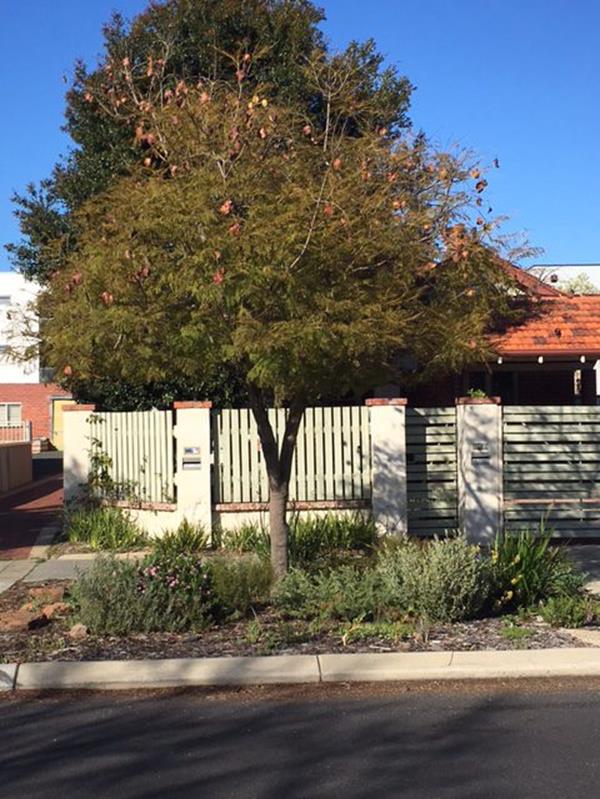
Another photo of this W.A. native road verge in 2016.
]
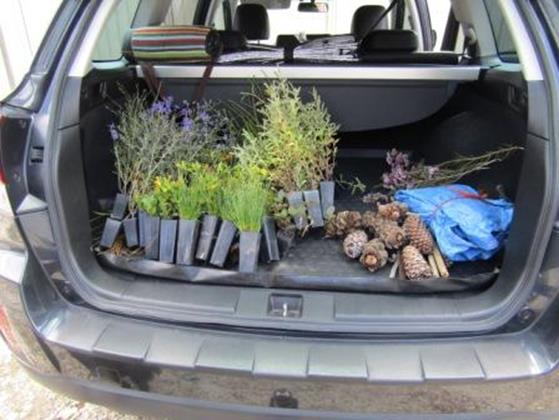
Using tubestock when you are planting is not only the best way to establish an Australian native garden, the plants are easily purchased from our retail nursery and can be transported in the car boot.
These gardens have been planted and are maintained by a group of garden volunteers who are Mundijong residents. This comes with a special wish this Christmas for Henry and his fellow volunteers who are doing a fantastic job. The majority of Mundijong residents would not know that these gardens are the work of fellow residents known as Garden Volunteers. I took these photos two days ago, in one more year the plants will be much bigger. In a couple of years the garden volunteers might have to do some pruning of bigger plants
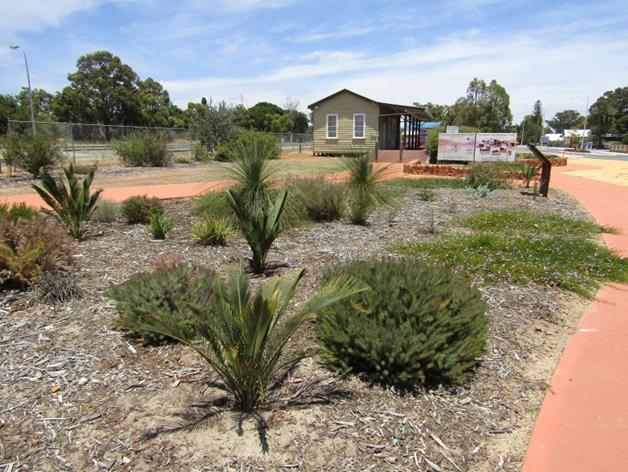
Native gardens that have been established and are regularly maintained by Garden Volunteers.
The plant in front is Macrozamia riedlei commonly called Zamia Palm. The two immediately behind are the beautiful Calothamnus hirsutus. It does not have a common name but can easily been seen growing in the Mundijong Road Reserve in Mundijong which is a Rare Flora Road Reserve. The prostrate bright geen foliage plant with masses of purple trumpet flowers is an attractive form of Hemiandra pungens commonly called Snake Bush. This flowers profusely over summer. There are several other species in the background but particularly prominent are the beautiful little Grass Trees Xanthorrhoea preissii. These Grass Trees will not grow tall trunks for many years but their foliage is always an attractive addition to native gardens.
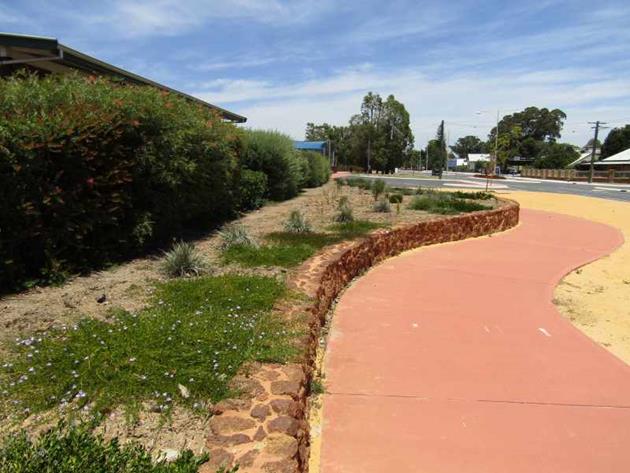
This is native garden which has been esablished by garden volunteers using local plant species.
This wall was built by prisoners from the Karnet Prison Farm. The planting by the garden volunteers has already enhanced the beauty of the wall even though the garden is still young. There are approximately 12 different native species in this section including the Common Smokebush Conospermum stoechadis which used to be very 'common' in Serpentine Jarrahdale, but is no longer. It is important to have as much bio-diversity as possible in our native flowerbeds to provide nectar for nectar eating birds and insects for the insect eating birds throughout the year. The dark green groundcover that can be partially seen on the bottom left is Dodonaea ceratocarpa a groundcover form and it can be seen repeated several times along the flowerbed. It is a plant that makes an excellent groundcover but little known and seldom used. All these plants were grown from tubestock size plants grown in our nursery.
Autumn certainly seems to have arrived, cooler days and gardening is certainly beckoning and we have received a small amount of rain in the last week. Things in nature are changing so fast that it is difficult to know what to include in our Living with Nature Diary. However, today I have decided to feature the beautiful Atriplex species commonly called Salt Bushes that we propagate for sale.
We have one Atriplex isatidea commonly called Coastal Saltbush growing in an area where there is no irrigation. I noticed today that it is beginning to flower but as you can see from the photos the flowers are not very noticeable but it is the large silver/grey leaves that are the attraction. We have several different Atriplex species for sale all of which have their own individual and interesting silver/grey leaves. When growing Atriplex in gardens they are extremely waterwise but some can grow quite large and pruning will help to control them.
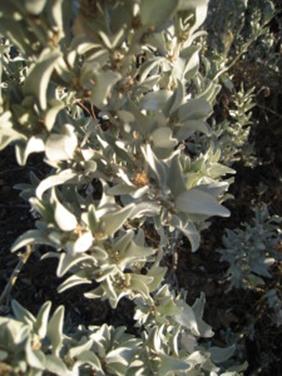
Atriplex isatidea or Coastal Saltbush grows up to 2 metres and flowers from March to June. It requires pruning to keep it looking neat.
The following photos are of different Atriplex that are growing in tubes on our nursery benches.
There are over 40 Atriplex species native to Western Australia.
The Atriplex undulata is native to Wickepin and will grow in heavy clay. The other Atriplex here are to be found in many areas throughout Western Australia and are adaptable to many different soil types.
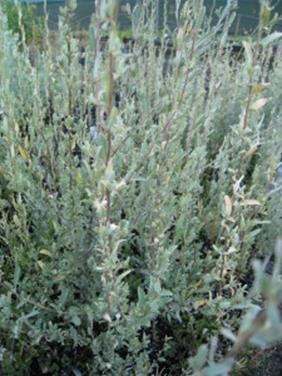
Atriplex amnicola which has a common name of Swamp Saltbush. This grows into a shrub about 1m tall and makes an attractive garden plant. It grows well in all soils including coastal areas.
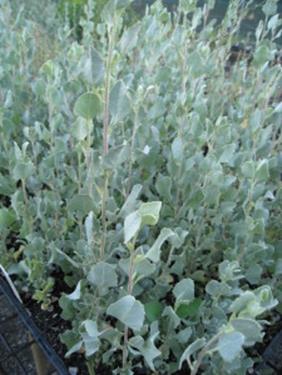
Atriplex nummularia or commonly called Old Man Saltbush. Grows 1-3m tall and the grey foliage adds beauty to any garden.
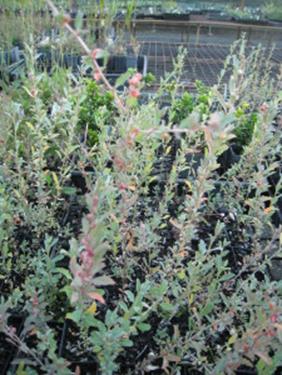
Atriplex semibaccata or Berry Saltbush, an almost prostrate plant. It has small white flowers and is useful in dry hot areas of the garden.
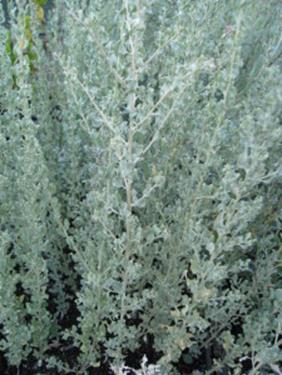
Atriplex undulata (it does not have a common name).
The beautiful Calytrix fraseri commonly called the Pink Summer Calytrix. It grows 0.2-1m high. It prefers to grow in sand, white, grey and yellow, and will also grow on coastal dunes. Summer Flowering. This is a photo taken in our nursery display flower beds.
It is native to the following Local Government Areas: Armadale, Bayswater, Boyup Brook, Bruce Rock, Busselton, Capel, Carnamah, Cockburn, Coorow, Dandaragan, Dumbleyung, Gingin, Gosnells, Harvey, Irwin, Kalamunda, Kondinin, Kulin, Kwinana, Melville, Moora, Murray, Narrogin, Northam, Northampton, Perth, Serpentine-Jarrahdale, South Perth, Stirling, Swan, Three Springs, Victoria Plains, Wandering, Wanneroo, Wickepin, York. (This information, and more, can be found on the Florabase website).
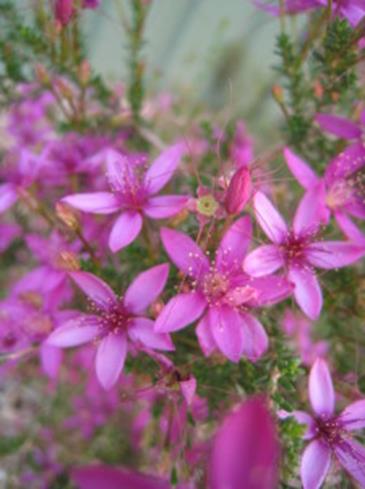
Calytrix fraseri.
This is a photograph of the whole plant which is approximately 0.3m high in our flowerbed.
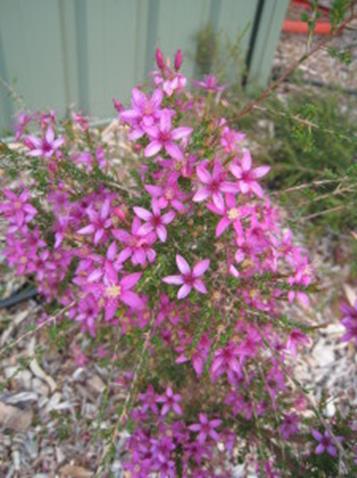
We have recently propagated many Calytrix fraseri and this is a photgraph of a small one flowering in a tube.
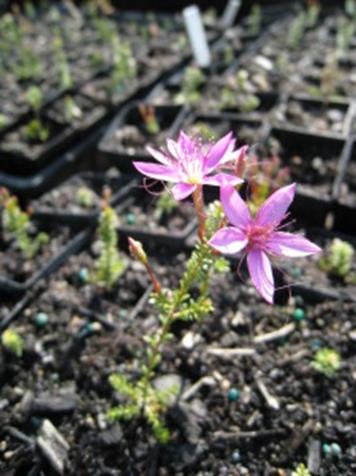
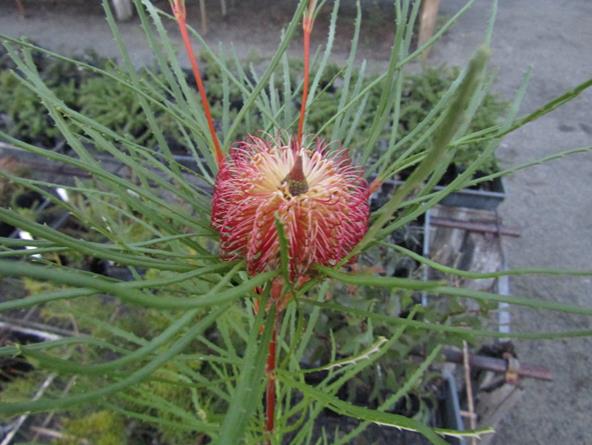
A young Banksia occidentalis commonly known as the Red Swamp Banksia growing in a forestry tube.
Banksia occidentalis is described as a shrub or a small tree and can grow up to 7 metres. When grown in a pot its growth would be restricted so it would make an attractive pot plant for its green fine leaves as well as its flowers. The Botanist, Alex George, describes it as sometimes reluctant to flower. Perhaps that could be when it is growing in the bush where life can be harsh for plants. It prefers growing in peaty sand, or sand in low lying moist areas. It was first collected by Robert Brown in 1801 near King George Sound, on the south coast of Western Australia. It is native to the south coast from Augusta to Cape Arid. The flowers in mature plants are bigger than the one I have photographed here. Alex George describes the flowers as golden with styles of metallic red which is a lovely description. Other people use descriptions like yellow, orange with red styles.
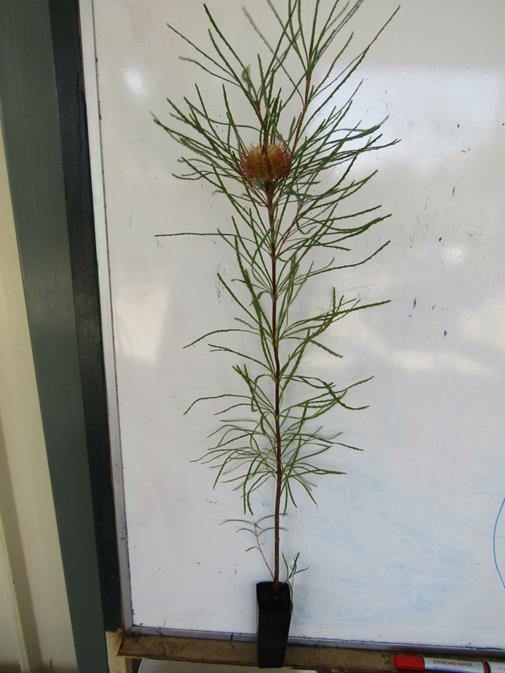
Banksia occidentalis or Red Swamp Banksia showing the whole plant growing in a tube.
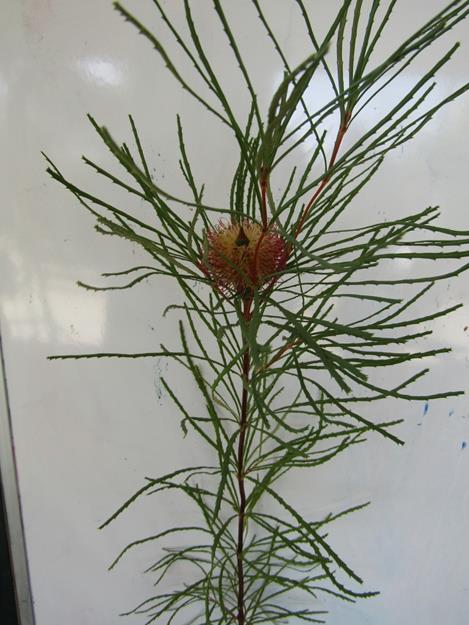
This beautiful flower on this young Banksia occidentalis would make an excellent pot plant as well as an addition to a sandy garden where it can be kept moist.
There are many Western Australian Banksias that can make attractive garden plants and can also be grown in pots. It is important to remember that Banksias do not like phosphorous in the potting mix or in your garden, so do not add any fertilizer once planted in your garden and only use a controlled native fertilizer sparingly when growing in a pot. It is important to keep the mix in the pots moist but not too wet.
Reference: Alex S. George The Banksia Book, Kangaroo Press in association with The Society For Growing Australian Plants - NSW Ltd. (There is no date in the book).
Hello Nancy.
Thank you for your expert advice. With your help and guidance I have transformed my yard and life! Literally. I am so into Native Plants. I think you will like the before and after shots!
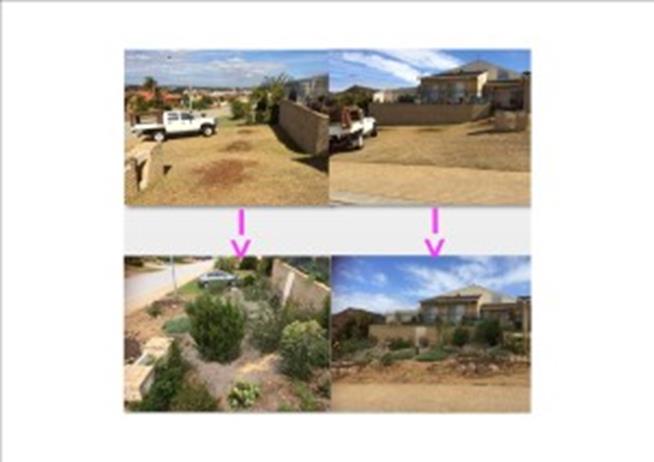
Steve said "I used to drive down the street looking at girls; now I drive down the street looking at Native plants!"
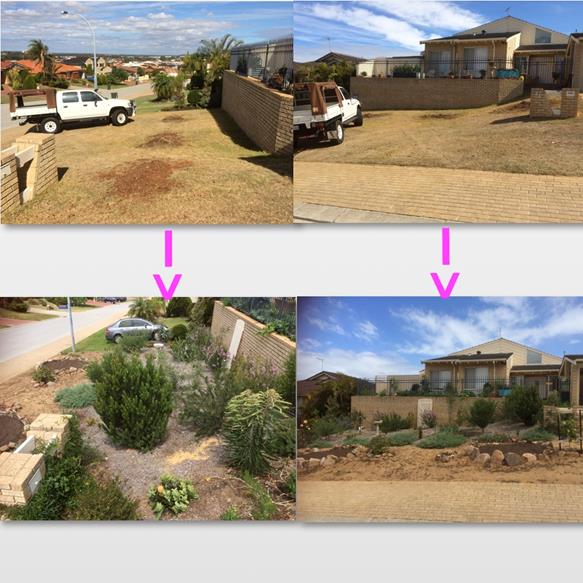
Steve's comment about his Australian native garden "I used to drive down the street looking at girls; now I drive down the street looking at native plants!"
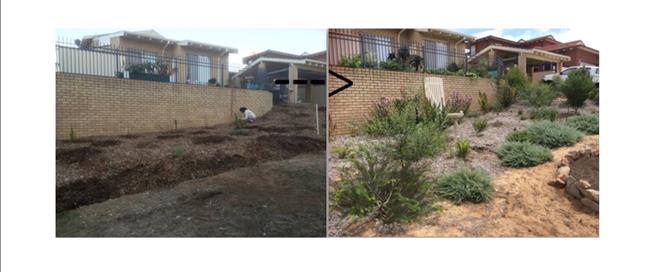
Another of Steve's comments about his Australian native garden "No water, no maintenance, more birds, more beauty".
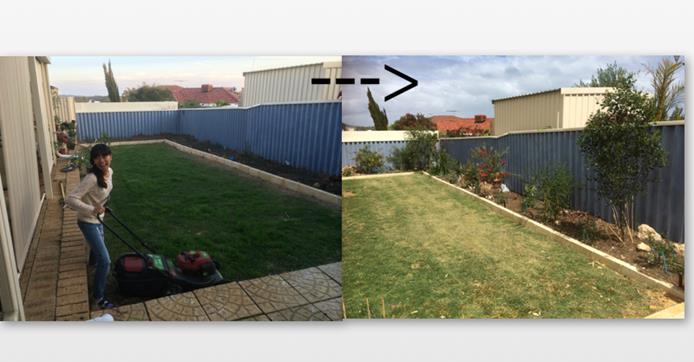
Steve's Australian native garden at the back of his house. Steve's wife, Janet, is having to do the hard work maintaining the lawn!
Our Living with Nature Diary 10th May, 2015.
We need lots of rain but this cooler weather is the time to start planning your garden and start planting providing you are able to water the plants every day until it rains. If you cannot water, then wait for the rain. Unfortunately this cooler weather encourages slugs, snails, weeds and scales. I have found a soft brown scale on our Eucalyptus forrestiana Fuschia Gum that we have growing in a large pot at the entrance to our nursery. I cut off as much of the scale as I could and then put ring of Vaseline around the trunk of the tree to stop the ants climbing up the tree. Usually scales are associated with a large number of ants. Ants frighten away the natural enemies of the scale and they also move the scale from one plant to another. If the infestation is bad a thorough application of white oil at a rate of 20ml per litre of water is recommended. Scales can also be removed with a brush or gloved fingers if the numbers are small. The scale suck sap from the plant and as a result they produce large quantities of honeydew which is a sugary solution that the ants love. The honeydew falls onto other parts of the plant and the result is a very unattractive sooty mould.
Soft brown scale infestation on Eucalyptus forrestiana. The ants can be clearly seen in this photograph.
